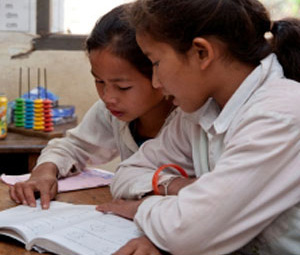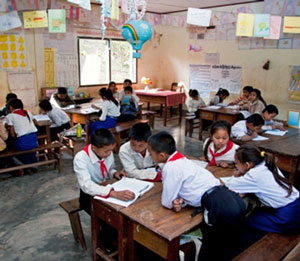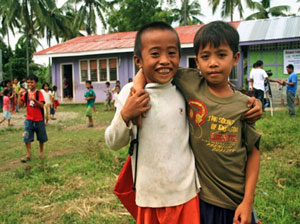Australian and World Bank support for the Global Partnership for Education contributes to the provision of mobile teachers to remote villages without a school in Laos, tackling a major cause of non-attendance by primary-age children, particularly girls. Photo: Bart Verweij, AusAID
Education is one of the best development investments. It is transformational for individuals, families and societies, and is critical to the achievement of all Millennium Development Goals and other development outcomes.
As the largest external education financier for developing countries, the World Bank is a key player in global efforts to reach the Millennium Development Goal of universal primary education by 2015, and works to help countries reap the full benefits of education through learning for all.
The World Bank and Australia are active partners in the Global Partnership for Education [external website], the only global partnership focused on basic education in developing countries. In 2011, Australia pledged $270 million over four years (2011–15) to this partnership, the second largest commitment in this period. The Global Partnership for Education is helping to improve access to education for children in 49 low-income countries, including 11 in Asia and the Pacific. It focuses strongly on gender parity–in particular, providing more girls with better access to education at the primary and junior secondary levels–and encourages a focus on gender as a core part of government education policy.
Supporting girls' education in Laos
Australia and the World Bank are helping to improve girls' access to quality education in Laos. Photo: Sounisa Sundara, AusAID
A program funded by the Global Partnership for Education is improving access to and the quality of pre-primary and primary education in 60 of Laos' most educationally disadvantaged districts, where girls' enrolment in primary education has traditionally been lower. In time, the program will improve access to a quality education for more than 170,000 children.
The program builds on the Lao Government's commitment to provide a safe educational environment for girls. Overcoming the barriers girls face to attending school not only increases their quality of life but improve a nation's health, food production and economic growth.
The program will provide mobile teachers to remote villages without a school, tackling a major cause of non-attendance by primary-age children, particularly girls. Education officials and teachers will be trained and learning materials provided. More than 2,700 classrooms will be constructed in primary schools across Laos.
Strengthening the Philippines' education system
Australia and the World Bank are helping the Government of the Philippines provide quality education to its children, including those living in conflict-affected areas in Mindanao. Photo: AusAID
Australia and the World Bank are working in partnership with the Government of the Philippines to address the enormous challenges associated with fixing an education system under stress.
Since 2008, the program has helped build 559 classrooms and six learning centres, which have improved the learning environment for more than 22,000 students. The program has also helped the Department of Education to develop strategies and policies. As a result, we are now seeing improvements in teaching and learning competencies, including school-based management; competency-based standards for hiring, promotion, training and supervision of teachers; accreditation of schools; monitoring and evaluation of education products and services; and mother-tongue based multilingual education.



